Huzhou in Zhejiang Province is well-known among numismatists because it is the home of senior numismatic collector and researcher Chen Danong. As a famous Chinese saying goes, "no matter how high the mountain is, its name will spread far if there is a sage." On June 6th 2015, hundreds of coin collectors came to Huzhou to celebrate his 100th birthday. The attendees recalled the more than 70 years of Mr. Chen's collecting and research (Pic.1).
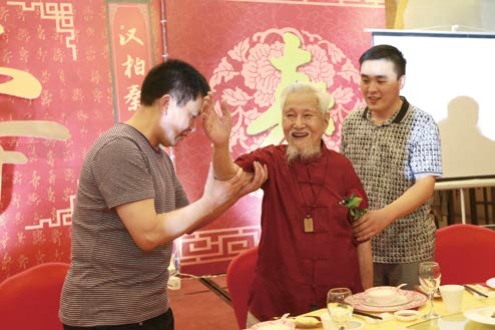
Pic.1 (From L) Chen's student Zhao Jinxing, Chen Danong, his grandson Chen Qi at his 100th birthday party
Chen Danong, styled himself as Jing Ji (敬吉) [and was also known as Si Xian Zhai Zhu (四顯齋主) and Xi Sai Quan Sou (西塞泉叟) ] was born in Lianghu town, Shangyu city in 1916, and grew up in Huzhou City. His ancestors were farmers, and his father ran a silverware shop. He converted to Christianity at the age of 19 and later received his bachelor’s degree from North China Theological Seminary. At 40 years old he became a teacher and pastor of the Baptist Church on East Street in Huzhou, he later concurrently served as the principal of Min De Primary School. In 1977, he started working in an antique store, a subsidiary of the Huzhou Museum, after he was rehabilitated from "anti-rightist" wrongs. As an amateur archaeologist for about 40 years, he was particularly fond of ancient coins. He was a member of the Chinese Numismatic Society and director of the Zhejiang Province Numismatic Society. In 2011, he was honorably awarded as one of top ten collectors of Zhejiang Province. In August 2015, he was offered to serve as the honorary president of the Huzhou Numismatic Society after he ended his three successive terms as the vice president since the Society was founded in 1991 (Pic.2). Needless to say, he has contributed a lot to numismatic collecting and research in Huzhou.

Pic.2 The 2014 Huzhou Numismatic Society Seminar hosted by Chen Danong (M)
From the age of 20, when he became attached to ancient coins, Chen Danong has been enriching his collection and has regularly conducted numismatic research. He has set a good model for younger numismatists with his rich collecting experience, deep appreciation of numismatics and rigorous research. In addition to his collecting and research he has educated and instructed younger collectors which has won him accolades from other numismatists.
Collection
When Chen Danong was a teenager he found a large charm on which was inscribed "live as long as the turtle and the crane" (meaning "longevity") in a family cabinet. It was his first experience with ancient Chinese coins. At the age of 25, he obtained 200 ancient Chinese coins from his mother; that was 75 years ago. At its peak his collection consisted of around 4,000 coins, some of which were auctioned and given away as donations, some were lost and some were stolen. Now only 2,000 pieces are left. However, included in the remaining pieces are such rarities as a "Hsian Feng Pao Su" 500 cash and a large "Yung An" 1000 copper cash coin. Unlike today, when people can easily buy coins online or in auctions, at that time Chen Danong began collecting he had to go everywhere to find rare coins; from remote mountainous areas to downtown flea markets and coin shops. He constantly enhanced his collection by trading with collectors, purchasing from coin dealers and being presented coins as gifts by friends.
I) From the collectors: Chen Danong’s made good friends with Pan Lanjiang, who was a much older collector and famous doctor in Huzhou. Pan presented him a numismatic book and later gave him 100 ancient coins plus a "Jing Kang Yuan Pao" seal and clerical script 2 cash coins as the guarantee for three years of rent for Pan’s daughter. At the age of 31, Chen obtained five spade coins inscribed with the Chinese characters "Yang" (sun), "Yang" (sheep), "Wu" and "An Zang". He also obtained several other spade coins and "Chuan Hsing" coins from local epigrapher Wang Zousheng. Later he purchased 20-30 coins from Yao Muqing's father-in-law, including a "Ssu Chu", a "Ta I Tung Bao", and a "Kai Yuan Tung Pao" [with the Chinese character "Dan" on the reverse]. Subsequently he obtained a rare "Chih Pai Wu Chu"with an incused " " on te bottom of the reverse, a "Shun Chih Tung Bao" with the Chinese character "Er" (two) on the reverse and a "Shao Da Pan Fen" [silver 1/2 Fen] with round hole. At the age of 40, he bought a "Ting Chien" iron coin with seal script, a "Bao Chu Zhu Ren" and a "Han Yun" from Yuan Ke-wen's [Yuan Shih- kai's son] collection (Pic.3). This transaction was recorded in Ku I Pi Chih ("Ancient Leisure Coin Record", 古幣逸志) written by Yuan Ke-wen. It was said that this coin entered the market from Yuan's mistress. Chen felt extremely excited after he got the coin. In the same year, with the help of a priest, Gu Baozhang, he purchased an earthen jar of copper coins from the Bai Collection from Jiangdu (Yangzhou city) at the price of ¥34,000. These 100+ coins included rarities such as the silver "Hsi Wang Shang Kung" coin, a "Tien Tse Fu Pao", several "Yung An" 1000 cash copper coins (large size and small sizes), a "Tuan Ping Tung Pao" mother coin with the characters of "Hui Wu" and "Xi Shang" on the reverse, a "Lung Hsing Yuan Pao" one cash, a small "Ta You Yuan Pao" lead coin, a large "Tien Sheng Tung Pao" coin, an extremely large "Chia Ching Tung Pao" coin (Pic.4), a "Chien Yen Chung Pao" in which the inscription appeared on both sides, a large-sized "Ban-Liang" [半兩], a "Xin Mang Shi Bu" [十布] and several Szechuan iron coins. He obtained a large number of other ancient coins from then on (Pic.5).

Pic.3 A "Ting Chien" iron spade coin (ex-Yuan Ke-wen collection)
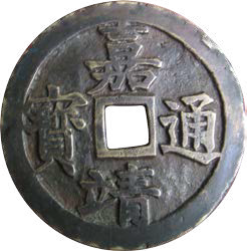 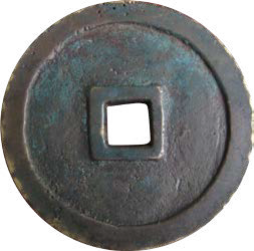 |
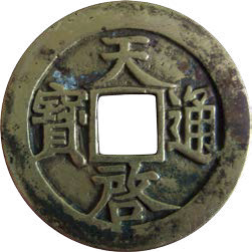  |
| Pic.4 A large "Chia Ching Tung Pao" coin | Pic.5 A "Tien Chi Tung Pao" 10 cash with 8 moons and 4 stars on the reverse |
II From coin dealers: In his forties, Chen bought hundreds of coins from a Fuzhen Collection from Mr. Zhang, a coin dealer, at the price of 2 tael 2 mace gold, which was equal to the value of 22 'dan' of rice (1 dan=60kg). Most of them were Qing dynasty coins including a rare "Cheng Te Tung Pao" with the characters "Xi Li" on the reverse. Other scarce coins included a "Tien Ming Tung Pao" with a Chinese character variety (copied from "Tien Chi Tung Pao"), a "Shun Chih Tung Pao" with the characters "Yuan Qing" on the reverse, a "Kang Hsi Tung Pao" 3 cash with the character "Xuan" on the reverse, a "Hsien Feng Chung Pao" Kiangsu Mint 50 cash (wide rim), a "Gun Zi Tung Qian" charm, a "Kuang Hsu Ban Zi" charm, and a "Chien Lung Tung Pao" (Yarkand Mint) double obverse coin. Moreover, there were 30+ coins struck by the Taiping Rebellion, Small Swords Society and the secret Golden Coin Society. He bought the first known "Hsien Feng Chung Pao" Kiangsu Mint 500 cash at the cost of one silver dollar, which was later stolen. It was said that it was flowed into Japan from Ding Zongqi (an ancient Chinese coin dealer in Suzhou) (Pic.6).
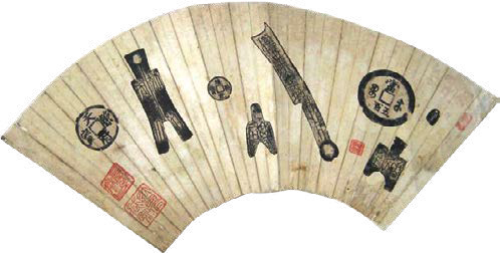
Pic.6 A fan rubbing with a "Hsian Feng Pao Su" 500 cash rubbing
III) By exchange and donation. Pan Lanjiang was particularly fond of amulets. Chen once exchanged 150 amulets for dozens of rare Ming knife coins with Pan. At the age of 77, he got a "Han Hsing" coin (with vertical writing) in a trade with Yuan Zhaoxiong in Deqing. Meanwhile, he received many coins from his friends and relatives. For example, Ni Juntou presented him with a fake "Ssu Chu". In 1993, his student Gao Yongyong presented him an "Ta Chuan" 500 cash money tree unearthed in Tongxiang to thank Chen for his kind help (Pic.7).

Pic.7 A "Ta Chuan" 500 cash money tree
It is worth mentioning that in the 1960s, Chen Danong discovered a large Taiping Rebellion "Zhen Ku" coin in Huzhou. He later donated it to the state and now it is kept in the Zhejiang Museum. At the age of 90, he sold a part of his collection through China Guardian Auctions and donated ¥500,000 from the ¥900,000 auction proceeds to charity.
Appreciation
Chen Danong said: "For coin collecting, it's not quantity that matters, but authenticity. Also the quality of coin rubbings should take priority to the size." He believed that, as a novice begins to collect coins, enthusiasm is most important. The collection's quantity relies on financial strength; authenticity will be determined by the collector's appreciation; gains or losses by decisiveness; achievement by perseverance. The most important thing is to verify authenticity of the coins. As for rare coins, he sticks to the following rules: the coins with fine characters are better than the fat ones, white copper is better than brass, thicker (piedfort) coins are better than regular coins, Ssu Jue [4 strokes] is better than Ssu Chu [4 rays from the corner of central hole], Shuei guo [the color of ancient mercury] is better than the old patina, a set is better than a single item. He accumulated a rich numismatic experience by reading many numismatic books and researching thousands of ancient coins every year.
I) Conclusion and Chen's ''10 key points'': It's really hard to identify the authenticity of ancient coins because of the large quantities, varieties, reverse inscriptions, patterns and the large number of counterfeits. However, Chen came up with 10 points to identify coins by using such components as the inscription, metal texture, size, weight, shape, and luster. Firstly, identify the quality of copper; second, identify the plain reverse; third, check if it has a rim; fourth, measure the width of the rim; fifth, measure size of the hole; sixth, understand hole patterns; seventh, check gradual changes of the outline of the inner hole of the coin; eighth, keep an eye on marks; ninth, check the star or moon pattern; finally, master the style. If one keeps these 10 points in mind and spends a long time examining many coins, one will easily figure out the inscription on the obverse when you observe the reverse of a coin.
II) Chen Danong particularly devoted himself to the identification of the Northern and Southern Song dynasty iron coins, Japan and Annam coins [modelled on Song dynasty coins] and Taiping Rebellion coins. Among his 200 Northern and Southern Song dynasty iron coin collection, half of them are rarities. In his opinion, the inscriptions can be imitated on fake coins, but the strokes lack power. A complete coin can be easily imitated, but it's hard to imitate a coin which is naturally worn. Iron counterfeits lack the patina of the genuine iron coins. The sound of the fake coins is 'harsh', while the genuine is 'mild'. The genuine old coins are easier broken than the newly struck counterfeits. Most coins from Japan and Annam modelled their inscriptions on Northern Song dynasty coins, and a few from the Southern Song dynasty coins. Most coins have a plain reverse, and those with "Zheng" or "Yuan" on the reverse are extremely rare. The "Kai Hsi Tung Pao" is the only one known with "Yuan" on the reverse. Japanese imitation cast coins can be divided into three categories, and four categories for imitation cast coins from Annam. The Japanese preferred coins with inscriptions read anti-clockwise while Annam never struck such coins. Most of the large Taiping Rebellion coins stuck in gold, silver, copper, iron, and even pewter are counterfeits. Those silver coins, regarded as the small commemorative medals and made by the Nanking Lao Feng Xiang silver jewelry store in the early Taiping Rebellion, were not circulating coins.
III) Chen was sharp-eyed regarding the counterfeits illustrated in well-known numismatic works and those in other collectors' collections. He pointed out that the large "Ta Chuan" 20 cash coin was a counterfeit in volume 7 of Chin Ting Chien Lu (A Coin Catalog - By Imperial Order, issued by Song Emperor Gaozong). There is a 2000 cash denomination but no 20 cash for this coin. The "Ying Tien Chung Pao" is not genuine while the "Ying Tien Tung Pao" is. An Encyclopedia of Ancient Coins (古錢大辭典) and its supplement by Ting Fu-pao are great numismatic masterpieces; however, about 20 of the coin photos illustrated in the books were not genuine coins, such as the knife coin with "qi" on the reverse, the "Tien Hsien Tung Pao" of the Liao dynasty, the "Tien Ying Yuan Pao", the "Tien Ying Tung Pao", the "Yuan Chih Tung Pao", the "Yung Ning Tung Pao", the "Liang Chin I Chu", large round "Tung Chou" coins with a center hole, and the large and small "Hsi Wang Shang Kung" gold coins. All of these are counterfeit. He also corrected errors about more than 30 ancient Chinese coins illustrated in the Japanese Catalog of Ancient Coins (古錢大鑒). In Ku I Pi Chih (Ancient Leisure Coin Record,古幣逸志) and Chuan Chien (A Coin Digest, 泉簡) both by Yuan Ke-wen, Chen found 30 counterfeits or questionable coins. What is more, he could identify the authenticity of famous collectors' collections such as Pan Lanjiang's. Pan devoted his life to his numismatic collection which he amassed with great financial support. He enjoyed great fame in numismatic circles by owning a Tang dynasty "Ta Zu Tung Pao" as well as numerous other rare coins. Chen Danong was in the right spot when Pan's son Pan Binzhang arranged the sale of his father's ex-collection after Pan passed away. He found about 1/3 of the collection to be counterfeits out of a total of 2,140 ancient coins. But Pan probably collected so many counterfeits for a reason. Chen illustrated the forgeries one by one in his book Illustrated Catalog of Ancient Coin Counterfeits (偽鑄古錢過目錄) which can still be used as a reference for young collectors.
IV) Instruct and educate young collectors and hold regular appreciation symposiums. Chen Danong enjoyed popularity in his local region for his kind and moral personality, his lavish collection and deep appreciation of Chinese coins. These attributes helped him attract many young numismatic learners. Since 1983, his four most outstanding students, Gao Yongyong, Cui Deming, Gao Daming and Zhao Jinxing, have regularly held meetings to identify the authenticity of coins and appreciate numismatics. Chen even once wrote a poem about it. Although there are differences between the five regarding their ages, occupations, education, and income, they are closely tied together by their common numismatic hobby, and enjoy sharing their experiences. They have made friends with other collectors through coins, discussing with each other which enriches their collecting experience and improves their insight into ancient Chinese numismatics (Pic.8).
Appreciation
Chen Danong said: "For coin collecting, it's not quantity that matters, but authenticity. Also the quality of coin rubbings should take priority to the size." He believed that, as a novice begins to collect coins, enthusiasm is most important. The collection's quantity relies on financial strength; authenticity will be determined by the collector's appreciation; gains or losses by decisiveness; achievement by perseverance. The most important thing is to verify authenticity of the coins. As for rare coins, he sticks to the following rules: the coins with fine characters are better than the fat ones, white copper is better than brass, thicker (piedfort) coins are better than regular coins, Ssu Jue [4 strokes] is better than Ssu Chu [4 rays from the corner of central hole], Shuei guo [the color of ancient mercury] is better than the old patina, a set is better than a single item. He accumulated a rich numismatic experience by reading many numismatic books and researching thousands of ancient coins every year.
I) Conclusion and Chen's ''10 key points'': It's really hard to identify the authenticity of ancient coins because of the large quantities, varieties, reverse inscriptions, patterns and the large number of counterfeits. However, Chen came up with 10 points to identify coins by using such components as the inscription, metal texture, size, weight, shape, and luster. Firstly, identify the quality of copper; second, identify the plain reverse; third, check if it has a rim; fourth, measure the width of the rim; fifth, measure size of the hole; sixth, understand hole patterns; seventh, check gradual changes of the outline of the inner hole of the coin; eighth, keep an eye on marks; ninth, check the star or moon pattern; finally, master the style. If one keeps these 10 points in mind and spends a long time examining many coins, one will easily figure out the inscription on the obverse when you observe the reverse of a coin.
II) Chen Danong particularly devoted himself to the identification of the Northern and Southern Song dynasty iron coins, Japan and Annam coins [modelled on Song dynasty coins] and Taiping Rebellion coins. Among his 200 Northern and Southern Song dynasty iron coin collection, half of them are rarities. In his opinion, the inscriptions can be imitated on fake coins, but the strokes lack power. A complete coin can be easily imitated, but it's hard to imitate a coin which is naturally worn. Iron counterfeits lack the patina of the genuine iron coins. The sound of the fake coins is 'harsh', while the genuine is 'mild'. The genuine old coins are easier broken than the newly struck counterfeits. Most coins from Japan and Annam modelled their inscriptions on Northern Song dynasty coins, and a few from the Southern Song dynasty coins. Most coins have a plain reverse, and those with "Zheng" or "Yuan" on the reverse are extremely rare. The "Kai Hsi Tung Pao" is the only one known with "Yuan" on the reverse. Japanese imitation cast coins can be divided into three categories, and four categories for imitation cast coins from Annam. The Japanese preferred coins with inscriptions read anti-clockwise while Annam never struck such coins. Most of the large Taiping Rebellion coins stuck in gold, silver, copper, iron, and even pewter are counterfeits. Those silver coins, regarded as the small commemorative medals and made by the Nanking Lao Feng Xiang silver jewelry store in the early Taiping Rebellion, were not circulating coins.
III) Chen was sharp-eyed regarding the counterfeits illustrated in well-known numismatic works and those in other collectors' collections. He pointed out that the large "Ta Chuan" 20 cash coin was a counterfeit in volume 7 of Chin Ting Chien Lu (A Coin Catalog - By Imperial Order, issued by Song Emperor Gaozong). There is a 2000 cash denomination but no 20 cash for this coin. The "Ying Tien Chung Pao" is not genuine while the "Ying Tien Tung Pao" is. An Encyclopedia of Ancient Coins (古錢大辭典) and its supplement by Ting Fu-pao are great numismatic masterpieces; however, about 20 of the coin photos illustrated in the books were not genuine coins, such as the knife coin with "qi" on the reverse, the "Tien Hsien Tung Pao" of the Liao dynasty, the "Tien Ying Yuan Pao", the "Tien Ying Tung Pao", the "Yuan Chih Tung Pao", the "Yung Ning Tung Pao", the "Liang Chin I Chu", large round "Tung Chou" coins with a center hole, and the large and small "Hsi Wang Shang Kung" gold coins. All of these are counterfeit. He also corrected errors about more than 30 ancient Chinese coins illustrated in the Japanese Catalog of Ancient Coins (古錢大鑒). In Ku I Pi Chih (Ancient Leisure Coin Record,古幣逸志) and Chuan Chien (A Coin Digest, 泉簡) both by Yuan Ke-wen, Chen found 30 counterfeits or questionable coins. What is more, he could identify the authenticity of famous collectors' collections such as Pan Lanjiang's. Pan devoted his life to his numismatic collection which he amassed with great financial support. He enjoyed great fame in numismatic circles by owning a Tang dynasty "Ta Zu Tung Pao" as well as numerous other rare coins. Chen Danong was in the right spot when Pan's son Pan Binzhang arranged the sale of his father's ex-collection after Pan passed away. He found about 1/3 of the collection to be counterfeits out of a total of 2,140 ancient coins. But Pan probably collected so many counterfeits for a reason. Chen illustrated the forgeries one by one in his book Illustrated Catalog of Ancient Coin Counterfeits (偽鑄古錢過目錄) which can still be used as a reference for young collectors.
IV) Instruct and educate young collectors and hold regular appreciation symposiums. Chen Danong enjoyed popularity in his local region for his kind and moral personality, his lavish collection and deep appreciation of Chinese coins. These attributes helped him attract many young numismatic learners. Since 1983, his four most outstanding students, Gao Yongyong, Cui Deming, Gao Daming and Zhao Jinxing, have regularly held meetings to identify the authenticity of coins and appreciate numismatics. Chen even once wrote a poem about it. Although there are differences between the five regarding their ages, occupations, education, and income, they are closely tied together by their common numismatic hobby, and enjoy sharing their experiences. They have made friends with other collectors through coins, discussing with each other which enriches their collecting experience and improves their insight into ancient Chinese numismatics (Pic.8).
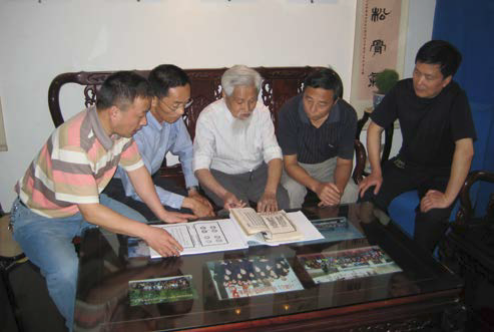
Pic.8 Chen Danong with his students at home. (From L) Gao Yongyong, Cui Deming, Chen Danong, Gao Daming, Zhao Jinxing
Research
Chen Danong devoted his life to numismatic research, and has authored five numismatic books since 2001: A Guide to Chinese Ancient Coins (古泉學入門), Appreciation on Ancient Chinese Coins (淙淙泉聲), The Numismatic Collection of Chen Danong (達農泉集), The Coins of the Taiping Rebellion (太平天國錢幣考略) and Comments on Numismatic Collecting (西塞泉叟集錢芻言) (Pic.9). His methodical writing helps cultivate numismatic culture, just as comments written by Tang Shifu in the preface for A Guide to Ancient Chinese Coins state, "This book tells us his precious experience and the essence of his numismatic collection. He provides his valuable advice and experience for learners in numismatic research." In 1995, the famous collector Dai Zhiqiang remarked: "It is easy to understand how he obtained his profound numismatic knowledge; his collecting experience is unique."
Chen Danong devoted his life to numismatic research, and has authored five numismatic books since 2001: A Guide to Chinese Ancient Coins (古泉學入門), Appreciation on Ancient Chinese Coins (淙淙泉聲), The Numismatic Collection of Chen Danong (達農泉集), The Coins of the Taiping Rebellion (太平天國錢幣考略) and Comments on Numismatic Collecting (西塞泉叟集錢芻言) (Pic.9). His methodical writing helps cultivate numismatic culture, just as comments written by Tang Shifu in the preface for A Guide to Ancient Chinese Coins state, "This book tells us his precious experience and the essence of his numismatic collection. He provides his valuable advice and experience for learners in numismatic research." In 1995, the famous collector Dai Zhiqiang remarked: "It is easy to understand how he obtained his profound numismatic knowledge; his collecting experience is unique."
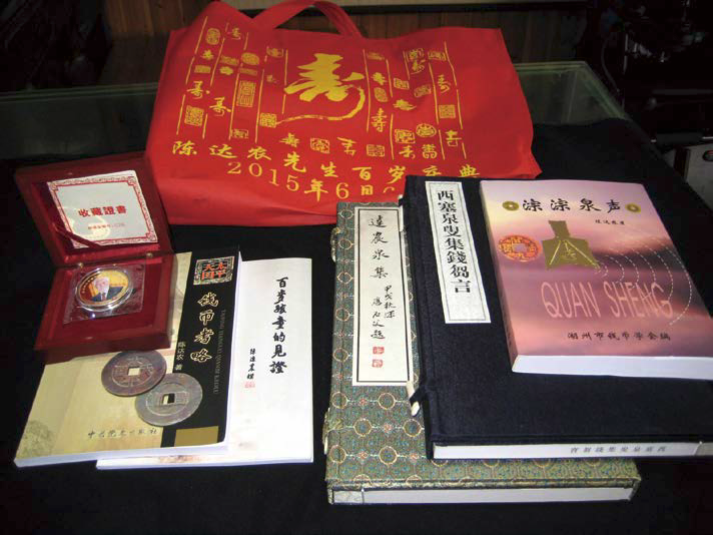
Pic.9 The five numismatic works authored by Chen Danong
I) From collection to appreciation and research. In his opinion, collectors not only collect coins and enjoy the beauty of calligraphy and the patterns, but should also understand the specific history of each coin. Each ancient Chinese coin reflects the historical culture of China. Chen purchased a great number of numismatic reference books for research. Once he got a rarity, he would check the date that the coin was struck, the mint, mintage, the inscription, the meaning of the patterns, the denomination, the metal and its relationship with the commodity prices at that time. He records every detail and makes comments. Then he would refer to numismatic resources to verify the authenticity of coins and write down his viewpoints. Finally he would arrange his findings by systematically writing them into a book. He comments that each coin has its own specific characteristics depending on the dynasty in which it is struck.
II) From local region. He knows well that collectors need to understand local numismatic history so he wrote the book Huzhou Numismatic History ( 吳興泉幣史沿革 ) which narrates Huzhou's history from the late Shang dynasty to the Qing dynasty, the mints, coins, coins that have been unearthed and the known population. All numismatic articles he wrote stick to the facts. For example, there are no official records and few private notes about Taiping Rebellion coins. When he wrote the book The Coins of the Taiping Rebellion ( 太平天國錢幣考略 ), he tried to avoid subjective assumptions by referring to the literature and real coins.
There have been ups and downs in his life, but Chen gets pleasure from his collection. Even now, at 100, he is in good health and has a quick mind. He often authenticates coins for collectors, and promotes the Huzhou Numismatic Society. He is one of the most famous Chinese collectors, a scholar and a teacher.
(Images courtesy of Gao Yongyong, vice president of the Huzhou Numismatic Society).
